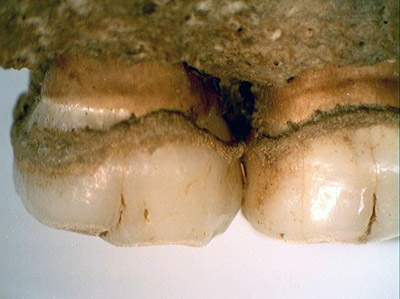Research project
Teeth Tell Tales
A multi-disciplinary approach to past lifestyles and cultural practices
- Duration
- 2008 - 2012
- Funding
-
 NWO Toptalent project number 021.002.097
NWO Toptalent project number 021.002.097
- Partners
Florida Museum of Natural History
St. Vincent and the Grenadines National Trust
St. Lucia Archaeological and Historical Society
Peabody Museum, Yale University
El Museo Del Hombre Dominicano, Dominican Republic
Centro de Investigaciones y Servicios Ambientales y Tecnológicos, Holguín, Cuba
Laboratorio de Antropología Forense y Bioarqueología, Universidad de Puerto Rico, Río Piedras
The Department for Anthropology, University of North Carolina, Greensboro
The Archaeological Museum of Aruba
St. Maarten Archaeological Research Center SIMARC

How does evidence from human dentitions contribute to knowledge of the lifeways and cultural practices of the pre-Columbian Amerindians of the Caribbean archipelago?
Short abstract
Human teeth hold a treasure trove of information on the behaviour and lifestyles of past populations, particularly regarding foodways and health and disease.
Project description
The project investigates human foodways, health and disease, and certain (gender-related) craft activities in the pre-Columbian Caribbean, through integrated analyses of patterns of dental wear and pathology in a large number of skeletal remains from the region. The multi-disciplinary approach, which combines archaeological, bioarchaeological, ethnohistoric, and ethnographic data, as well as evidence from clinical dentistry enabled a more sophisticated understanding of the dental anthropological data produced in this study.

Results
Hitherto unexplored aspects of lifeways and cultural practices in the pre-Columbian Caribbean were revealed. Individuals, communities, and regional populations were physically affected by their foodways and cultural practices, leaving permanent traces on their teeth. Differences were observed between sites, indicating that foodways varied per community, likely due to local environmental conditions and sociocultural preferences. However, the dental evidence indicates that most communities consumed large amounts of cariogenic plant foods, showing that agricultural/horticultural practices formed an important aspect of daily lifeways. Sex-based labour division may have resulted in slightly differing foodways between males and females, and resulted in females being more severely and frequently affected by dental disease.
Over time there was an increased focus on more refined, processed plant foods. This resulted in drastically contrasting dental wear and pathology profiles between the Early Ceramic Age (400 B.C. – A.D. 600/800) and the Late Ceramic Age (A.D. 600/800–1500), which coincide with broad scale social and environmental changes during the transition between these two periods. These changes are paired with changes in oral health, related to increased consumption of processed carbohydrates, but likely also symptomatic of population growth and increasing population density. Differences were observed between the sites, again suggesting that local conditions and sociocultural choices influenced health.
The teeth were frequently used in general task activities (such as clamping objects), showing that the mouth and dentition formed an integral part of embodied practice. Specific craft activities, such as cordage manufacture or basketry, were performed by a smaller portion of the population, and were associated more strongly with males than females.
